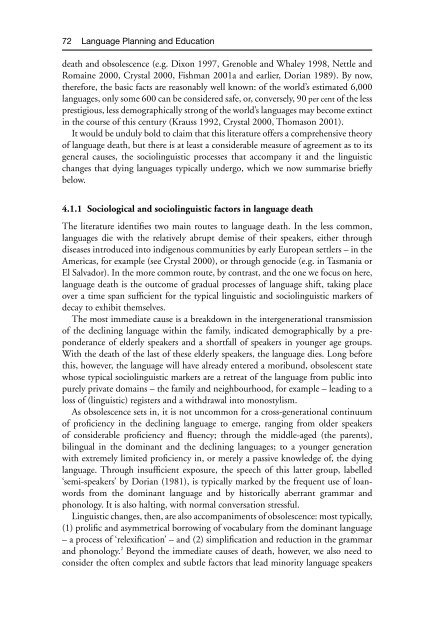Gibson Ferguson Language Planning and Education Edinburgh ...
Gibson Ferguson Language Planning and Education Edinburgh ...
Gibson Ferguson Language Planning and Education Edinburgh ...
Create successful ePaper yourself
Turn your PDF publications into a flip-book with our unique Google optimized e-Paper software.
72 <strong>Language</strong> <strong>Planning</strong> <strong>and</strong> <strong>Education</strong><br />
death <strong>and</strong> obsolescence (e.g. Dixon 1997, Grenoble <strong>and</strong> Whaley 1998, Nettle <strong>and</strong><br />
Romaine 2000, Crystal 2000, Fishman 2001a <strong>and</strong> earlier, Dorian 1989). By now,<br />
therefore, the basic facts are reasonably well known: of the world’s estimated 6,000<br />
languages, only some 600 can be considered safe, or, conversely, 90 per cent of the less<br />
prestigious, less demographically strong of the world’s languages may become extinct<br />
in the course of this century (Krauss 1992, Crystal 2000, Thomason 2001).<br />
It would be unduly bold to claim that this literature offers a comprehensive theory<br />
of language death, but there is at least a considerable measure of agreement as to its<br />
general causes, the sociolinguistic processes that accompany it <strong>and</strong> the linguistic<br />
changes that dying languages typically undergo, which we now summarise briefly<br />
below.<br />
4.1.1 Sociological <strong>and</strong> sociolinguistic factors in language death<br />
The literature identifies two main routes to language death. In the less common,<br />
languages die with the relatively abrupt demise of their speakers, either through<br />
diseases introduced into indigenous communities by early European settlers – in the<br />
Americas, for example (see Crystal 2000), or through genocide (e.g. in Tasmania or<br />
El Salvador). In the more common route, by contrast, <strong>and</strong> the one we focus on here,<br />
language death is the outcome of gradual processes of language shift, taking place<br />
over a time span sufficient for the typical linguistic <strong>and</strong> sociolinguistic markers of<br />
decay to exhibit themselves.<br />
The most immediate cause is a breakdown in the intergenerational transmission<br />
of the declining language within the family, indicated demographically by a preponderance<br />
of elderly speakers <strong>and</strong> a shortfall of speakers in younger age groups.<br />
With the death of the last of these elderly speakers, the language dies. Long before<br />
this, however, the language will have already entered a moribund, obsolescent state<br />
whose typical sociolinguistic markers are a retreat of the language from public into<br />
purely private domains – the family <strong>and</strong> neighbourhood, for example – leading to a<br />
loss of (linguistic) registers <strong>and</strong> a withdrawal into monostylism.<br />
As obsolescence sets in, it is not uncommon for a cross-generational continuum<br />
of proficiency in the declining language to emerge, ranging from older speakers<br />
of considerable proficiency <strong>and</strong> fluency; through the middle-aged (the parents),<br />
bilingual in the dominant <strong>and</strong> the declining languages; to a younger generation<br />
with extremely limited proficiency in, or merely a passive knowledge of, the dying<br />
language. Through insufficient exposure, the speech of this latter group, labelled<br />
‘semi-speakers’ by Dorian (1981), is typically marked by the frequent use of loanwords<br />
from the dominant language <strong>and</strong> by historically aberrant grammar <strong>and</strong><br />
phonology. It is also halting, with normal conversation stressful.<br />
Linguistic changes, then, are also accompaniments of obsolescence: most typically,<br />
(1) prolific <strong>and</strong> asymmetrical borrowing of vocabulary from the dominant language<br />
– a process of ‘relexification’ – <strong>and</strong> (2) simplification <strong>and</strong> reduction in the grammar<br />
<strong>and</strong> phonology. 2 Beyond the immediate causes of death, however, we also need to<br />
consider the often complex <strong>and</strong> subtle factors that lead minority language speakers






